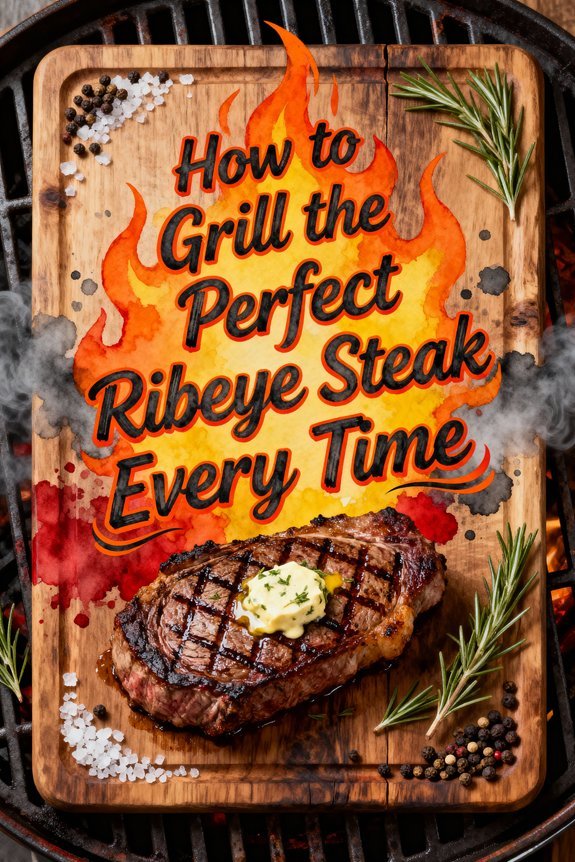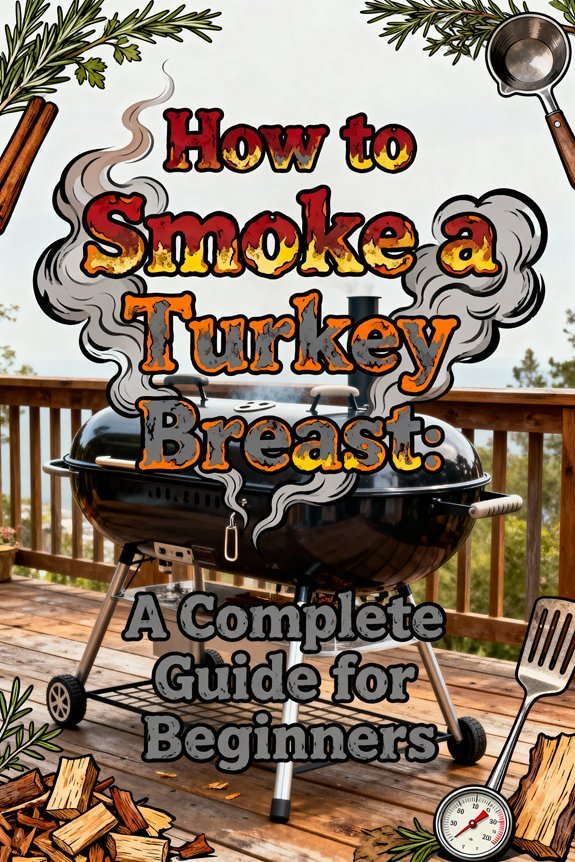To grill the perfect ribeye steak, start with a well-marbled USDA Choice cut and let it reach room temperature. Pat the meat dry, brush with high smoke-point oil, and season generously with kosher salt and pepper. Preheat your grill to 450-500°F, then sear the steak using precise timing based on thickness. For medium-rare, cook until internal temperature reaches 130-135°F, then rest for 5-10 minutes. Master these fundamentals to reveal steakhouse-quality results at home.
Essential Pre-Grilling Steps
While grilling the perfect ribeye begins long before the meat hits the grates, mastering a few essential pre-grilling steps will set you up for success. Start by selecting a well-marbled USDA Choice or higher ribeye, then remove it from refrigeration 20-45 minutes before cooking. During this time, pat the surface completely dry with paper towels for optimal moisture management. Cross-hatch marks on your steak can be achieved by rotating it at specific angles during cooking. Similar to burger preparation, maintaining a high heat range of 500-600°F will create an excellent sear on your ribeye.
Apply your steak seasoning generously, starting with kosher salt and freshly ground pepper. You’ll want to brush the meat with a high smoke-point oil like grapeseed before adding seasonings to guarantee better adhesion and crust development. Let the seasoned steak rest at room temperature, allowing the salt to penetrate the meat while your grill preheats to 450-600°F. This methodical preparation assures ideal conditions for achieving the perfect sear. Using a meat thermometer will help ensure consistent results every time.
Setting Up Your Grill for Success
Before you can achieve steakhouse-quality results, proper grill setup becomes the critical foundation for your ribeye’s success. Select your grill fuel carefully – gas provides consistent heat, while charcoal or wood adds distinctive smoky flavors. If you’re using charcoal, arrange it for a two-zone fire configuration, creating distinct hot and cool areas for ideal heat distribution. For an enhanced flavor profile, consider using mesquite wood for grilling. Just as low temperature cooking produces tender ribs, proper temperature control is essential for steak perfection. Top damper adjustments help maintain precise temperatures throughout the cooking process.
Preheat your grill thoroughly for 15-20 minutes until it reaches 500-600°F. While heating, clean the grates with a sturdy brush or aluminum foil ball to remove residue. Don’t oil the grates directly; instead, apply a high-smoke-point oil to your steak. Keep the lid closed to maintain temperature, but monitor frequently for flare-ups. Position your grilling tools and thermometer within easy reach, and ascertain your fuel supply is sufficient for the entire cooking process.
[affiai keyword=”grill thermometer and cleaning tools set” template=”carousel” count=”3″
Mastering Temperature and Timing
Temperature mastery stands as the defining factor between an average steak and a masterpiece. You’ll want to preheat your grill to 450-500°F for ideal searing, while monitoring your ribeye’s internal temperature closely. For medium-rare perfection, you’re aiming for 130-135°F final temperature. Just as medium heat grilling produces perfect results for corn in the husk, precise temperature control is crucial for steaks. Like internal temperature monitoring ensures perfectly smoked ham, using a thermometer is essential for steaks.
Your timing techniques should adapt to steak thickness: ½-inch cuts need 2-3 minutes per side, while 1-inch steaks require about 5 minutes on the first side and 4-5 on the second. For precise temperature control, pull your steak when it’s 10°F below target temperature, as it’ll continue cooking during rest. A digital thermometer is your best ally – don’t rely on timing alone. For thicker cuts, consider the reverse-sear method: smoke at 225°F until reaching 120°F internal, then finish with a high-heat sear. Bone-in or boneless cuts will deliver excellent flavor, so choose based on your personal preference.
The Art of Resting and Serving
After achieving the perfect sear and internal temperature, mastering the art of resting your ribeye becomes essential for peak results. You’ll want to rest thinner steaks for 5-7 minutes and thicker cuts for 10-20 minutes, using the general rule of 5 minutes per inch of thickness. During this essential resting period, loosely tent your steak with foil to retain warmth without steaming the crust. High smoke point oils help develop that delicious golden-brown crust during the initial searing process. Similar to grilling cod, monitoring temperature closely ensures optimal doneness and prevents overcooking.
For best resting techniques, monitor the internal temperature with a probe thermometer, aiming for 120-130°F at the center. When it’s time for serving tips, slice against the grain to maximize tenderness. Add a pat of butter immediately after removing from heat, and consider finishing with compound butter or light seasoning just before plating. You’ll know you’ve mastered the process when the juices redistribute evenly throughout the meat.
Expert Tips and Techniques
While mastering the basics of grilling ribeye is essential, implementing advanced techniques will elevate your results from good to exceptional. Begin by applying seasoning techniques that maximize flavor penetration – salt your steak 2-3 hours before cooking to allow proper absorption. You’ll enhance your flavor combinations by incorporating a two-zone fire setup, which gives you precise temperature control for both searing and finishing. The delicious Spinalis Dorsi muscle should be positioned away from intense direct heat to preserve its tender texture. For optimal searing and flavor development, maintain your grill temperature at 450-500 degrees throughout cooking. Consider using a reverse sear method by smoking the meat at 225°F for 30-50 minutes before the final sear.
For ideal results, flip your steak every 20 seconds rather than waiting several minutes between turns. This method creates a more uniform crust while preventing overheating. Monitor internal temperature with an instant-read thermometer, aiming for 115°F before resting. Remember to finish with compound butter and let the meat rest 5-10 minutes before serving to guarantee the juices redistribute properly.
[affiai keyword=”instant read meat thermometer for grilling” template=”carousel” count=”3″







